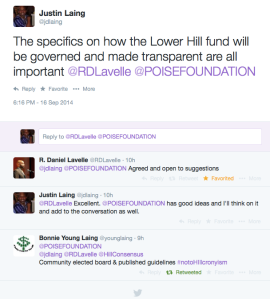Take two after losing the post I wrote last night. Last night, The Hill District Community Development Corporation (The Hill CDC) had a community meeting focused on two subjects: The recent deal outlining what would come back to the Hill from the gift given to the Penguins by our local government in order for them not to leave i.e. the rights to develop the 28 acres in the Lower Hill District. The second element of the meeting was an envisioning of what might happen on Centre Ave. As there were a lot of details and potential implications to both issues, I will not try to handle this all in one post. First- what I heard from Councilman Daniel Lavelle re: the deal on the Lower Hill.
I came in on the tail end of the presentation and so the part that I was able to hear pertained to a fund that will be created to spur development in the entire Hill. According to the Councilman, the fund will get its dollars from a TIF or Tax Increment Financing deal that will send 65% of the increase in taxes raised by the redevelopment of the Lower Hill to the Hill District Growth Fund and 35% back to the City of Pittsburgh. TIFs are something I am still trying to get my head around, so I hope to come back to that in a later post, but the headlines that I heard are the following:
- the deal could lead to anywhere from $22 million to $70 million in dollars to fund development across the Hill District;
- the signatories were the Mayor, the Councilman, the Penguins and the Hill District CDC;
- the committee currently managing the Hill District Growth Fund will appoint new members to the body and other political entities, such as the city or county will not be able to weigh in on who sits on the committee;
- the agreement will be posted on the Councilman’s page.
Questions from the audience ranged from how would the fund be governed and ensured to benefit the Hill District residents to could the fund help with the eventual tax increases that property owners in the Hill will face as a result of the new development, which is a fascinating idea in and of itself. Wouldn’t that mean from a taxing strategy perspective that the city was developing property in the Lower Hill to raise taxes for its own operations, sending a chunk back to the Hill to help it redevelop “itself” (the Hill is still a part of the City) and then some of these same dollars were then coming back to the City treasure chest in the form of abatements given to residents to offset the the taxes caused by the redevelopment? Owning two properties in the Hill, I can’t say I’m mad about that idea, and what I like about it is that it essentially means that Hill District residents would not have to incur the same price for the redevelopment of their neighborhood, but could reap the benefit in increased home values. Interesting.
Anyway, the Councilman’s response on making sure the dollars allocated to the Hill were actually going to benefit the Hill had much to do with governance. Here he talked about the way the current members of the committee managing the Hill District Growth Fund would manage these dollars and that this committee would be the only one with the power to appoint new members, so that there could be no interference from other entities such as the City or County. This was posited as community control and while it surely will be controlled by residents and stakeholders of the Hill District (there was a resident clause to the membership on the committee that I missed), I have raised questions going back a couple of years as to how “community” is operationalized. This will be key if the fund is going to provide anything approaching equal access to all ideas and not be severely weighted towards those close to the Councilman and the Hill District CDC, which can happen even without intentions of graft, corruption and the like. Funding organizations (and I work for one) are notorious for providing access based on proximity to the board and staff of the organization, so this fund, garnered in the name of the Hill District community, has both the opportunity and burden of actually developing a process that leads to attracting and fairly funding all kinds of community ideas and to date. One idea I suggested two years ago that I don’t believe has happened and was not mentioned last night was to rotate members of the committee governing the fund.
The opportunity is to set a standard for how communities could decide funding processes and priorities for themselves and that all kinds of funding orgs, like philanthropy, government and intermediaries could learn from or be encouraged to take up. From what I can see this hasn’t happened to date I was encouraged that the Councilman spoke of a need to think about the processes governing the fund, but said it was best to speak to the POISE Foundation as to how this would actually happen. In a later twitter exchange that included my wife, Dr. Bonnie Young Laing, who has written about anti-displacment policies and how cronyism helps to foster and preserve slums, Councilman Lavelle weighed in that he agreed that the governance of the fund and its transparency was all important.
As Mayor Peduto has said this is the largest TIF deal in the city’s history, there will be much to think about as to how this will benefit the neighborhood and I am very glad we have this to think, talk and act about.



